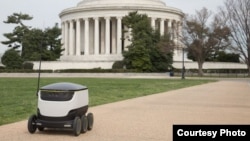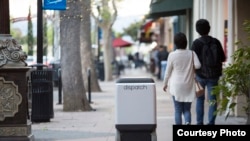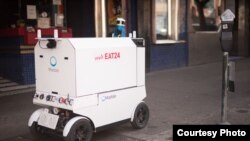One of the latest trends in technology is the creation of personal robots to help people with day-to-day activities.
Some companies are testing driverless robots to bring food and other products directly to customers.
One such service is already operating on the streets of Washington, D.C. Starship Technologies launched several self-driving robotic vehicles in the city earlier this year.
The six-wheeled electric machine sits about a half-meter high. It has a box to carry small groceries or food products, up to nine kilograms in weight.
Users can order the robot service through an app – a software program -- on a smartphone. The food or other things remain safe and secure inside the vehicle until the consumer orders the app to open the compartment.
The robotic vehicles move themselves along sidewalks, using camera and tracking technology to avoid people, cars and other objects. Each robot has lights and a red flag on top to help people recognize them.
Someone is always following the robots’ movements from a distance. The company admits that someone might try to steal or block the robots. But it adds that such an individual would be easy to catch because of the machine’s cameras and tracking system.
Another company, Dispatch, also has been testing a delivery robot. This robot is a little taller than the one working in Washington. The door of the Dispatch is on the side of the robot and slides up to open the compartment. It operates along city sidewalks or the edge of streets.
In April, another business launched a robotic delivery service in San Francisco, California. Marble is partnering with the food delivery company Yelp Eat24 to provide door-to-door robot service.
The Marble robot is somewhat bigger than the others and has a more industrial look. But it works the same way. Orders are placed through an app, the machine makes the autonomous delivery, and a computer code is used to unlock the goods.
Marble is looking to expand its delivery service from San Francisco to other cities. It also plans to offer the ability to change conditions inside the compartment from hot and cold, or cold to hot, depending on what is being carried.
A company in China has taken robot delivery to the extreme by putting a whole mini market on wheels. The creators of Moby Mart say they have invented the world's first self-driving supermarket.
Engineers from Swedish company Himalafy worked with a team from China’s Hefei University of Technology on the project. Another partner is Sweden’s Wheelys, which owns many movable coffee stands.
Moby Mart is about the size of a small bus. It offers many products found in most convenience stores. They include milk, lunch meats, fruits and medicine.
The service has been tested in the city of Shanghai in recent months. Designers say that when fully operational, Moby Mart will use electricity powered by the sun.
People enter their location through an app and the vehicle then drives itself to the location and stops. A customer then enters a code to enter the “mini market” and chooses the desired items. Goods are scanned by phone and paid for through the app.
The company has said the cost of building Moby Mart is less than $100,000, about one-tenth the cost of a traditional store.
Another robot could be used in the future to deliver beer and other drinks. For this purpose, researchers at Massachusetts Institute of Technology or MIT created vehicles they are calling “beerbots.”
The system is actually a team of robots programmed to serve customers at a bar or restaurant. One big robot gathers cans of beer, which it places into smaller, four-wheeled robots. These “turtlebots” autonomously make the drink deliveries and take orders.
The MIT researchers used artificial intelligence (AI) to try to get the robots to reason on their own. The idea is to have them use human-like thinking to provide the best service.
The team found the beerbots had problems reacting to difficult situations just like humans would. But the researchers were surprised by other AI successes. They are continuing to find new ways to use reasoning methods in other robot applications.
I’m Bryan Lynn.
Bryan Lynn wrote this story for VOA Learning English. George Grow was the editor.
We want to hear from you. Would you trust a self-driving robot to deliver your food? Write to us in the Comments section, and visit our Facebook page.
_______________________________________________________________
Words in This Story
customer – n. person who buys goods or services from a business
delivery – n. the act of taking something to a person or place
groceries – n. food and other goods sold in stores to be used at home
autonomous – adj. engaging in an activity separately from other things
bar – n. place where people go to drink
scan – v. to read or mark something
location – n. the position or placement of something
convenience – adj. designed for quick and easy use
trend – n. a general movement or development
artificial intelligence – n. the development of computers to perform intelligence-related tasks without human involvement












